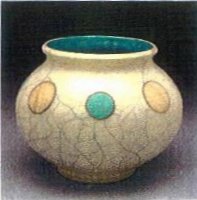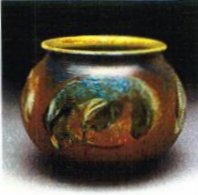Bruce Grimes
 “My work derives its inspiration from personal experience and historical references. Using clay as my medium I create both functional and artistic pieces without the help of asistants or apprentices. The functional wheel-thrown work is high-fired and emphasizes form, design and color. The artisitc pieces are raku-fired and focus on images of animals and symbols representing personal interpretations of life experiences and commentary.”
“My work derives its inspiration from personal experience and historical references. Using clay as my medium I create both functional and artistic pieces without the help of asistants or apprentices. The functional wheel-thrown work is high-fired and emphasizes form, design and color. The artisitc pieces are raku-fired and focus on images of animals and symbols representing personal interpretations of life experiences and commentary.”
“In either high-fired, or raku-fired work, my focus continues to be form and design. The high-fired functional work takes into consideration the function, aesthetics, and the user. From this I create a full line of functional pottery that accents household space and use. I mix my own clay bodies and glazes, and fire the pieces to approximately 2400° F. My glazes and designs are developed to enhance the individual pieces, not to overwhelm the piece, but to beautify it. the functional work is wheel-thrown.”
“Primarily, I work with stoneware and raku clays. The high-fire process provides continuing opportunities to explore form and color. The raku process provides me a chance to explore imagery and color while experiencing the immediacy that raku firing allows. I mix my own raku clay bodies and glazes, and do the post-firing reduction in straw. I have been involved with the raku process for almost forty years and have exhibited it in over 200 shows and galleries both nationally and regionally.”
“Most of the elements of the created form are wheel-thrown. The surface then becomes the “cavnas” for my painted and graphic images. The process enables me to work with fluid thrown forms, altering and designing each piece as an entity within itself. I am particularly interested in the formal aspects of creativity in getting each piece to work aesthetically. Balance, color, and rhythm all function within the structure of the work. The inherent elements of the form are enhanced by the color and design to give each piece its own statement and character. Each formal decision in the creative process can be viewed alone or as a part of the whole. A balance is established between the rhythm of the form and the surface design. The challenge is to create something of beauty and value from a material that starts as a lump of clay.”



